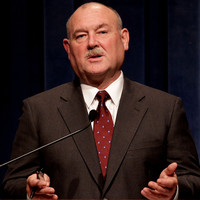BP Completes Cementing Macondo Oil Well From Top
BP Plc completed a cement plug at the top of its Macondo well in the Gulf of Mexico, sealing off the source of millions of gallons of oil spewed into the sea after a drilling rig exploded in April.
The procedure completes the so-called static kill. The next stage for BP is to finish a relief well to inject cement at the bottom and ensure there’s no leakage inside the 13,000-foot-long (3,962 meters) well bore beneath the seabed, National Incident Commander Thad Allen said yesterday.
The well, about 40 miles (64 kilometers) off Louisiana, spilled about 4.9 million barrels after the April 20 explosion of the Deepwater Horizon rig. BP temporarily plugged it with a stack of valves on July 15. The U.S. will keep 835 oil-skimming vessels near the site until the bottom kill is completed, Paul Zukunft, the federal coordinator, said on a call yesterday.
“Even with the static kill, to me, as the federal on-scene coordinator, that does not buy me the full assurance that that well is permanently shut-in,” he said. “We’re not out of the woods yet, out of the well site, until we have a permanent well kill.”
BP rose 2.4 percent to 433.65 pence as of 10:55 a.m. in London. The shares are down 34 percent since the accident in April that killed 11 workers.
The relief well will probably intercept Macondo in the middle of this month, BP said in a press release. BP will need at least five days to drill the final 100 feet, Allen told reporters in Washington.
Tropical Storms
The company will drill in small increments, interrupting the work for ranging tests to determine its accuracy.
BP said yesterday it’s evaluating how effective the static kill has been. Since the company doesn’t know the condition of the pipes in the damaged well, it needs time to figure where the mud and cement went and use the data from the static kill to better design the interception with the relief well, Allen said.
The timing of completion of the relief well will depend on the weather, as a tropical storm could delay drilling operations, BP said. Tropical Storm Colin today was approaching Bermuda with maximum sustained winds of 45 miles per hour.
The U.S. reduced its forecast for the 2010 Atlantic hurricane period to 14 to 20 named storms, down from 14 to 23, because of less activity than expected in the first two months of the season.
Eight to 12 of those storms are expected to grow into hurricanes with winds of 74 miles per hour (119 kilometers per hour) or greater, and four to six may become major systems with winds of 111 miles per hour or more, Gerry Bell, the lead seasonal hurricane forecaster for the U.S. Climate Prediction Center in Camp Springs, Maryland, said yesterday.
Asset Sales
BP, which plans to sell as much as $30 billion of assets to pay for the spill, has agreed to sell properties in Colombia for $1.9 billion as well as $7 billion of fields in the U.S., Canada and Egypt to Apache Corp.
The company paid $303 million in claims to more than 40,000 individuals and businesses hurt by the spill, BP said in a separate e-mail. BP reported a record loss of $17.2 billion in the second quarter after a charge related to the blast and environmental damage.
About 74 percent of the oil that leaked from the Macondo well has been eliminated or will soon be eaten by bacteria, a U.S. government report released this week showed.
Teams in Florida, Mississippi and Alabama have started removing the plastic barriers previously put on the water to prevent oil from reaching the beaches, Zukunft said.
“The well is dead,” Les Ply, a retired consultant to the oil industry on drilling and plugging wells, said by phone. “I don’t expect it to flow anymore.”
To contact the reporters on this story: Katarzyna Klimasinska in Houston at kklimasinska@bloomberg.net; Jim Polson in New York at jpolson@bloomberg.net.
©2010 BLOOMBERG L.P. ALL RIGHTS RESERVED. To subscribe or visit go to: http://www.bloomberg.com
